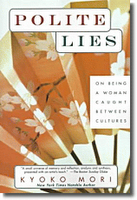
Kyoko Mori does a more thorough job with that objective than I did. She is the author of three novels (Shizuko's Daughter, One Bird, Stone Field, True Arrow) and two nonfiction books (The Dream of Water, Polite Lies).
Mori grew up in Kobe and left Japan for the United States at age 20. For Salon, she recommended some "books that illuminate the austere rigor of beauty that's the essence of Japanese culture."
These works include The Pillow Book of Sei Shōnagon (circa 990) by a lady-in-waiting to the empress who recorded her impressions of court life in notebooks, and The Narrow Road to the Deep North and Other Travel Sketches, travel writings by the 17th century haiku master Basho.
Mori also suggest Kazuo Ishiguro's novel, An Artist of the Floating World (1986), which is "set in an unnamed Japanese city in 1948, [and] explores the darker side of Japan's preoccupation with beauty and discipline."
Finally, there are these two books:
Yuko Tsushima was a year old in 1948 when her father, the famous novelist Osamu Dazai, committed double suicide with a bar waitress. The seven stories in her 1
988 collection, The Shooting Gallery and Other Stories, feature single mothers, abandoned wives and middle-aged daughters of aging parents in contemporary Tokyo. The landscape is gritty and harsh--old houses are replaced by warrenlike concrete buildings, parks become dumping grounds for unwanted pets, and the beach is cold and full of trash. This collection reveals a segment of the population seldom seen in the news.
But back to Kyoto, where the American poet Henri Cole, who spent the first two years of his life in Japan with his parents, returned alone in 2001. He is the perfect companion for any visitor who travels to this land of Zen and urban alienation in search of beauty and self-knowledge. His sonnets about Japan, collected in Middle Earth (2003), are as perfectly trimmed as the cherry trees my mother once admired: In them, restraint becomes freedom. The hydrangeas blooming in the rocky soil of a charity hospital offer "that atmosphere of pure/ unambiguous light burning inwardly,/ not in self-regard but in self-forgetting." Like Tsushima's characters, Cole is beset with insects that bring him insight: A praying mantis mocks his air of "romantic suffering" and forces him to be honest; a dead dragonfly placed in a rice bowl becomes a still-life composition of his essential loneliness. "I want a feeling of beauty/ to surround the plainest facts of my life," Cole declares in a poem titled "My Tea Ceremony." Sei Shōnagon and Basho (and my mother, too) would have agreed.
The blogger at "Lost in Translation" was disappointed in Mori's literary guide:
It omits the big three of Japanese literature (Mishima, Tanizaki, and Kawabata), the only Nobel Prize recipient, Kenzaburo Oe, and the most popular Japanese writer today, Haruki Murakami.... Other authors who were omitted include Endo, Atagawa, Ryu Murakami, Banana Yoshimoto-just to mention a few.Other items in Salon's series include:
A literary guide to Martha's Vineyard--Marshal Zeringue
A literary guide to West Texas
A literary guide to Togo
A literary guide to Brooklyn
A literary guide to Miami





